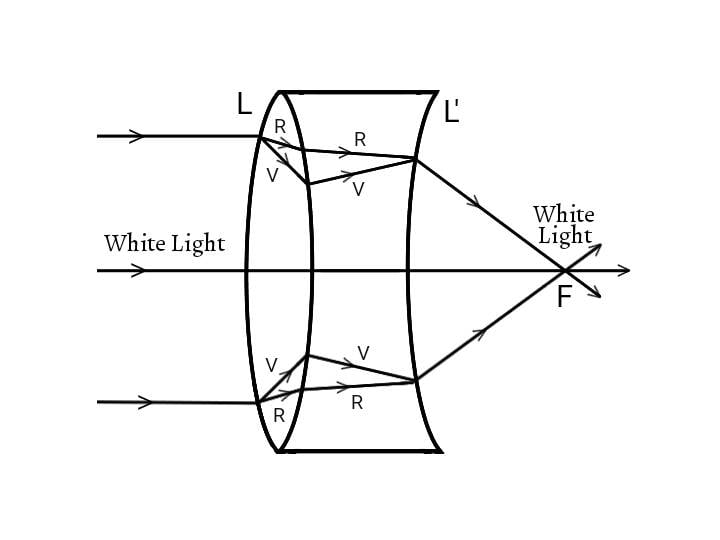Combining two lenses can overcome the chromatic aberration in them. Therefore, when two lenses are combined in such a manner that the combination is free from chromatic aberration, then such a combination is called achromat or achromatic aberration combination of lenses.
Consider two thin lenses $L$ and $L’$ of materials of dispersive power $ω$ and $ω’$ respectively are placed in contact with each other as shown in figure.

Let $(μ_v, μ, μ_r)$ and $(f_v, f, f_r)$ be the refractive indices and focal lengths of the material of the lens $L$ for violet, mean and red light respectively. Let $R_1$ and $R_2$ be radii of curvature of the two surfaces of lens $L$.
Let $(μ_v’, μ’, μ_r’)$ and $(f_v’, f’, f_r’)$ be the refractive indices and focal lengths of the material of the lens $L’$ for violet, mean and red light respectively. Let $R_1’$ and $R_2’$ be radii of curvature of the two surfaces of lens $L’$.
For lens $L$, the focal length of the lens for mean light is given by, \[\frac{1}{f}=(μ-1)\left(\frac{1}{R_1}+\frac{1}{R_2}\right)\] \[\left(\frac{1}{R_1}+\frac{1}{R_2}\right)=\frac{1}{f(μ-1)}\]
The focal length of the lens $L$ for violet light is given by, \[\frac{1}{f_v}=(μ_v-1)\left(\frac{1}{R_1}+\frac{1}{R_2}\right)\]
Substituting the value of $\left(\frac{1}{R_1}+\frac{1}{R_2}\right)$, \[\frac{1}{f_v}=\frac{μ_v-1}{f(μ-1)}\]
Similarly, focal length of lens $L’$ for violet light is given by, \[\frac{1}{f_v’}=\frac{μ_v’-1}{f’(μ’-1)}\]
If $F_v$ is the focal length of the combination of the lenses for the violet light, then, \[\frac{1}{F_v}=\frac{1}{f_v}+\frac{1}{f_v’}\] \[\frac{1}{F_v}=\frac{μ_v-1}{f(μ-1)}+ \frac{μ_v’-1}{f’(μ’-1)}\]
Similarly, the focal length of the combination of the lenses for the red light, then, \[\frac{1}{F_r}=\frac{μ_r-1}{f(μ-1)}+ \frac{μ_r’-1}{f’(μ’-1)}\]
Condition for Achromatic Aberration
If the combination is achromatic, the violet and red rays will come to focus at a single point i.e.
\[F_v=F_r\]
\[\frac{1}{F_v}=\frac{1}{F_r}\]
\[\frac{μ_v-1}{f(μ-1)}+ \frac{μ_v’-1}{f’(μ’-1)}= \frac{μ_r-1}{f(μ-1)}+ \frac{μ_r’-1}{f’(μ’-1)}\]
\[\left[\frac{μ_v-1}{f(μ-1)}- \frac{μ_r-1}{f(μ-1)}\right]+\left[\frac{μ_v’-1}{f’(μ’-1)}- \frac{μ_r’-1}{f’(μ’-1)}\right]=0\]
\[\left[\frac{(μ_v-1)-(μ_r-1)}{f(μ-1)}\right]+\left[\frac{( μ_v’-1)-(μ_r’-1)}{f’(μ’-1)}\right]=0\]
\[\left[\frac{μ_v-μ_r}{f(μ-1)}\right]+\left[\frac{μ_v’-μ_r’}{f’(μ’-1)}\right]=0\]
\[\text{We have, }ω=\frac{μ_v-μ_r}{μ-1} \text{ and, }ω’=\frac{μ_v’-μ_r’}{μ’-1}\]
\[\text{Therefore, }\frac{ω}{f}+\frac{ω’}{f’}=0\]
This is the condition for achromatism for two thin lenses in contact.
Since the dispersive power is always positive, $ω$ and $ω’$ are positive. Therefore, $f$ and $f’$ should be of opposite signs i.e. if one lens is convex then the other should be concave.
The two thin lenses cannot be of same material. If the two lenses are of same material then $ω=ω’$.
\[\therefore\frac{ω}{f}+\frac{ω}{f’}=0\] \[\frac{1}{f}+\frac{1}{f’}=0\] \[\text{Also, }\frac{1}{f}+\frac{1}{f’}=\frac{1}{F}\] Where, $F$ is the focal length of the combination of two thin lenses in contact.
\[\text{Thus, }\frac{1}{F}=0\] \[F=∞\] Therefore, if the lenses are of same material, then a beam of light will neither converge nor diverge on passing through the combination. Hence, two lenses cannot be of same material.
[Also See: Dispersion]
